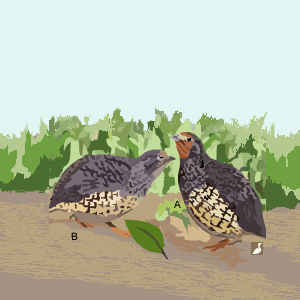Magazine | Études
Redécouverte du Perdicule du Manipur après 75 ans d’asbence

Perdicules de Manipur (Perdicula manipurensis) : (A) mâle et (B) femelle.Schéma : Ornithomedia.com
Introduction
Le Perdicule de Manipur (Perdicula manipurensis) est une espèce proche des cailles qui était autrefois présente dans les plaines herbeuses humides de plusieurs régions indiennes (Bengale, Assam, Nagaland, Manipur et Meghalaya). Il a été collecté pour la prmeière fois puis décrit en 1881 par Allan Octavian Hume lors qu’une expedition au Manipur. C’est un oiseau discert, mais à cause principalement de la destruction de son habitat, il est aujourd’hui devenu très rare. Aucune donnée confirmée n’a d’ailleurs été reportée entre 1932 et 2006. Au mois de juin de cette dernière année, un ornithologue confirmé, Anwaruddin Choudhury, a annoncé avoir observé un Perdicule de Manipur dans le parc national de Manas situé dans l’état de l’Assam. Il l’a vu posé et en vol lors d’une visite d’une équipe de l’Embankment & Drainage Department devant réaliser des travaux dans la zone.
Abstract
The Manipur Bush-quail (Perdicula manipurensis) is a shy and very rare a species that inhabits in damp grassland, particularly tall grass, and sometimes bogs and swamps, and even the foothills. According to records, it was generally sighted in small groups of four to 12, and was shy, reluctant to fly and extremely difficult to observe, although coveys were occasionally seen feeding in the open on recently burnt ground. It is endemic to northern West Bengal, Assam, Nagaland, Manipur and Meghalaya. Its range previously extended to Bangladesh.
It was first collected and described by Allan Octavian Hume on an ornithological expedition to Manipur in 1881. It is listed as Endangered on the IUCN’s Red List, as its habitat is small, fragmented, and rapidly shrinking. There were no confirmed sightings of the bird from 1932 until June 2006, when Anwaruddin Choudhury reported spotting the quail in Assam.
Mr Choudhury, an Indian wildlife enthusiast claimed to have sighted a nearly extinct bird, Manipur Bush-quail at a wildlife sanctuary in Assam. Choudhury, the district magistrate of Baska in western Assam and an avid bird watcher and wildlife expert, said he spotted the Manipur Bush-quail at the 500 square km Manas National Park earlier this month while on an official visit. The Manipur Bush-quail, one of the world’s most endangered birds listed in the Red Data Book of the International Union for Conservation of Nature (IUCN), was sighted last around 1932 by an Indian Civil Service officer and ornithologist J.C. Higgins in Manipur. « It was like a flash when the bird appeared in front of our jeep and soon vanished inside the thick undergrowth,’ Choudhury said.
Poursuivez la lecture de cet article, en vous abonnant dès maintenant !
Découvrez les Archives d’Ornithomedia.com
Pour seulement 10,00 €TTC/an (ou 6,00 € les 6 mois)
Profitez de plusieurs centaines d’articles en accès illimité et sans aucun engagement.
Compléments
À lire aussi sur Ornithomedia.com
- Les oiseaux du parc national de Keoladeo (Inde)
- Première observation du Vautour indien au Népal
- Bilan 2012 du suivi de la migration des rapaces à Thoolakharka (Népal)
- Observer les vautours et les aigles dans la décharge de Jor Beed
- Un espoir pour les vautours du sous-continent indien
Ouvrages recommandés
- Handbook of the Birds of India and Pakistan de Salim Ali (Auteur) et Ripley S. Dillon (Auteur)
- Birds of Northern India de Richard Grimmett (Auteur) et Tim Inskipp (Auteur)




Aucun commentaire sur ce sujet
Participer à la discussion !